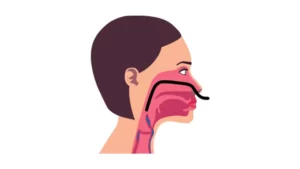Flexible Nasoendoscopy
Home | Services | Voice, Throat & Swallowing | Flexible Nasoendoscopy
What is flexible nasoendoscopy?
 Flexible nasal endoscopy is a procedure that is used to look inside the nasal cavity, back of the nose, voice box and back of the throat and tongue. An endoscope is a type of flexible telescope.
Flexible nasal endoscopy is a procedure that is used to look inside the nasal cavity, back of the nose, voice box and back of the throat and tongue. An endoscope is a type of flexible telescope.
It is a very common and quick procedure which does not require general anaesthesia, and can be performed under local topical anaesthesia in the outpatient clinic, ward or emergency department.
Why do i need flexible nasoendoscopy?
Patients who have problems with the ear, nose, throat or voice box may need to have this procedure.
What can i expect with flexible nasoendoscopy?
The endoscope is a narrow, thin flexible tube telescope with a bright light. In a standard fiberoptic endoscope, the image is transmitted through lots of very fine glass fibres to an eyepiece or camera. Sometimes a video camera is sited at the end of the endoscope and the picture is displayed on a screen.
This thin flexible tube is passed through the nostril and allows us to examine the nasal cavity and back of your nose, back of the tongue, throat and/or voice box whilst you are awake. Looking at these areas helps us make a diagnosis. You may be asked to swallow or breathe through your nose.
You can breathe in and out through your nose and mouth during the procedure. You may also be asked to say some words, noises or sentences out loud.
The procedure usually only lasts a few minutes and can be performed with or without local anaesthetic. There are minimal after effects, though the sensation in the nose and throat can take an hour to return to normal if local anaesthetic is used. During this time you should not eat or drink hot foods or beverages until the anaesthetic wears off. Some people find the loss of sensation very uncomfortable as they feel like they cannot breathe or swallow saliva. Patients will receive their nasal endoscopy findings immediately after the procedure.
With flexible nasoendoscopy risk of disease transmission is minimal as the scope is sterilized between patients with a specialized commercial solution.
What are the risks of Flexible Nasoendoscopy?
Flexible endoscopy is a very safe procedure for both children and adults. In children the procedure may trigger breath-holding attacks, so the procedure should be performed in an environment with nursing staff and equipment to help with breathing.
The nose may feel uncomfortable and you may feel the sensation of something in your throat, and may also cause your eyes to water. The procedure may trigger a cough. Rarely, patients may experience a nose bleed after the procedure.
Flexible nasendoscopy has the potential to produce airborne aerosols and droplets should you sneeze or cough during the procedure. If local anaesthetic is used, it may be put in to your nose up to 10 minutes before the procedure.
Frequently Asked Questions
What Is Nasal Endoscopy Used To Diagnose?
A nasal endoscopy is a diagnostic test that allows a doctor to view the inside of the nasal passages and sinuses. It is used to diagnose conditions such as sinusitis, nasal polyps, and other nasal and sinus disorders.
What Is The Meaning Of Nasoendoscopy?
Nasoendoscopy is a medical term that refers to a diagnostic procedure in which a thin, flexible tube with a light and camera (endoscope) is inserted through the nostril into the nasal and sinus cavities for examination. It is also referred to as a nasal endoscopy or nasal scope.
How Painful Is A Nasal Endoscopy?
A nasal endoscopy is generally not painful and most patients describe the discomfort as mild to moderate. Some temporary discomfort, such as a tickling or itching sensation in the throat or nose, may be felt during the procedure, but it is usually brief and tolerable.
How Is A Nasal Endoscopy Performed?
A nasal endoscopy is performed by an ear, nose, and throat (ENT) specialist or an otolaryngologist. The patient either sits up lies on their back, and the endoscope is inserted through one nostril and advanced into the nasal and sinus cavities. The doctor then examines the inside of the nasal passages and sinuses and may take samples of any suspicious tissue for biopsy.
How Long Is Recovery From Nasal Endoscopy?
Recovery from a nasal endoscopy is usually quick and painless. The procedure itself only takes a few minutes, and patients are usually able to return to their normal activities immediately afterward. Some mild discomfort or a feeling of pressure in the nose and sinuses may be felt for a short period after the procedure, but this usually subsides quickly.
What Are The Side Effects Of Nasal Endoscopy?
The most common side effects of a nasal endoscopy are temporary discomfort, a feeling of pressure in the nose and sinuses, and mild bleeding from the nose. Some patients may also experience a brief feeling of fullness in the ears or a tickling or itching sensation in the throat or nose. These side effects are usually minor and resolve quickly.
Is Nasal Endoscopy Considered Surgery?
No, a nasal endoscopy is not considered a surgical procedure. However, some insurers may classify it as a day surgery procedure. It is a diagnostic procedure that does not involve any incisions or surgical intervention.
Are You Awake For Nasal Endoscopy?
Yes, patients are awake during a nasal endoscopy. Local anesthesia may be used to numb the nasal passages and sinuses, but patients are not typically sedated or put under general anesthesia.
Does Nasal Endoscopy Require General Anaesthesia?
No, a nasal endoscopy does not typically require general anesthesia. However, some patients may opt for local anesthesia to numb the nasal passages and sinuses and reduce any discomfort during the procedure.
Which Is Better - Nasal Endoscopy Or A CT Scan?
The choice between a nasal endoscopy and a CT scan depends on the patient and the condition being evaluated. CT scans are useful for evaluating nasal and sinus anatomy and identifying structural abnormalities, but nasal endoscopy provides a more direct view of the interior of the nasal passages and sinuses. Nasal endoscopy is often used to diagnose conditions like sinusitis and nasal polyps. The best option may depend on the patient’s specific needs and the doctor’s recommendation, and in some cases, a combination of both may be necessary to make a diagnosis.
What Are The Two Main Types Of Nasal Endoscopy?
The two main types of nasal endoscopy are flexible and rigid endoscopy. Flexible endoscopy uses a thin, flexible tube with a light and camera to examine the nasal passages and sinuses. Rigid endoscopy uses a rigid metal instrument and is used in some cases where a more detailed view is needed, such as evaluating the anatomy of the nasal septum; or when procedures in the nose need to be performed.
Voice Conditions
Throat / Swallowing Conditions
Procedures & Treatments
- Tracheostomy
- Microlaryngoscopy with Phonosurgery
- Flexible Nasoendoscopy
- Direct Laryngoscopy
- Removal of ingested foreign body








